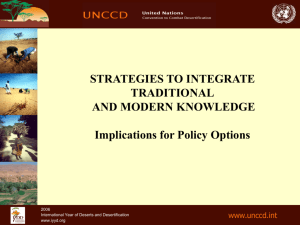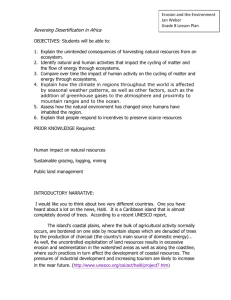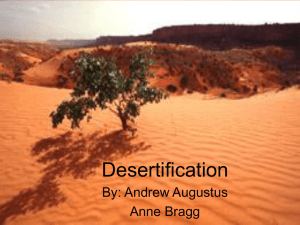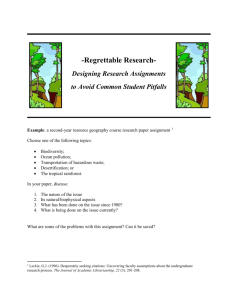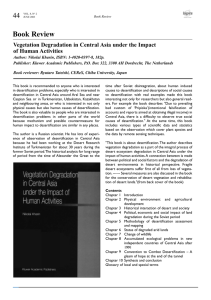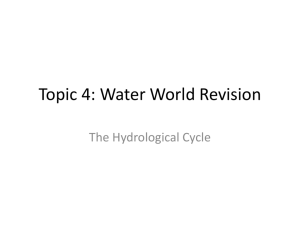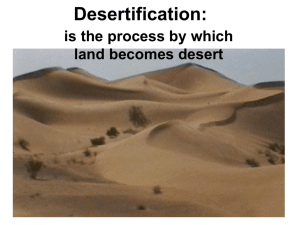DESERTIFICATION STATUS MAPPING USING
advertisement
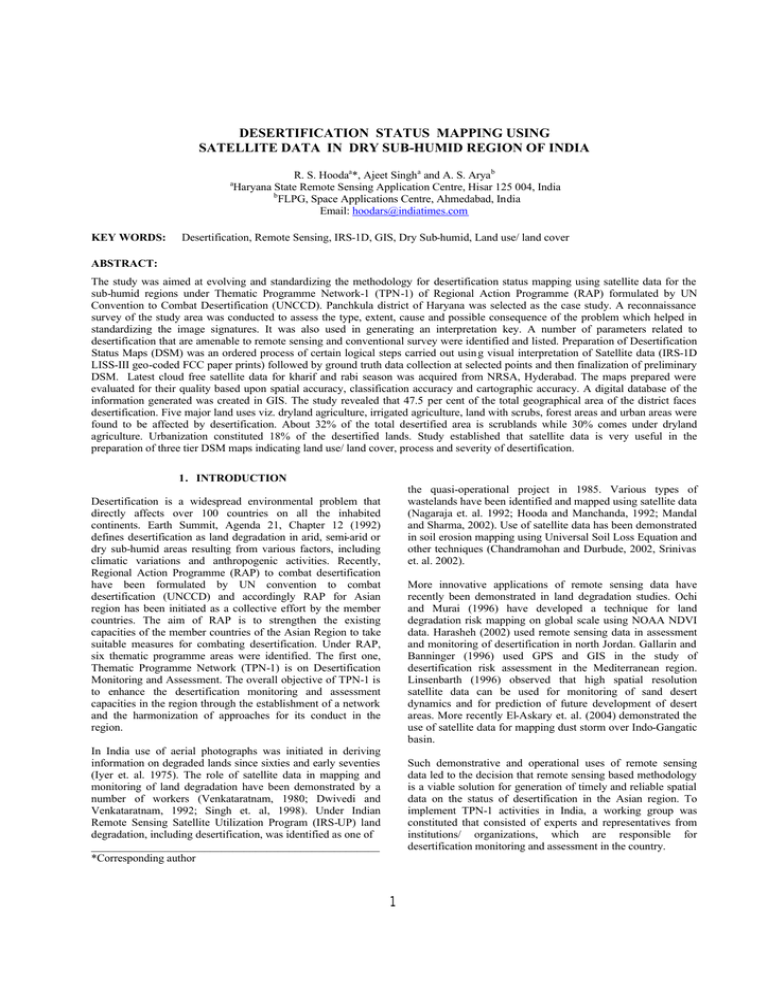
DESERTIFICATION STATUS MAPPING USING SATELLITE DATA IN DRY SUB-HUMID REGION OF INDIA R. S. Hoodaa*, Ajeet Singha and A. S. Arya b Haryana State Remote Sensing Application Centre, Hisar 125 004, India b FLPG, Space Applications Centre, Ahmedabad, India Email: hoodars@indiatimes.com a KEY WORDS: Desertification, Remote Sensing, IRS-1D, GIS, Dry Sub-humid, Land use/ land cover ABSTRACT: The study was aimed at evolving and standardizing the methodology for desertification status mapping using satellite data for the sub-humid regions under Thematic Programme Network-1 (TPN-1) of Regional Action Programme (RAP) formulated by UN Convention to Combat Desertification (UNCCD). Panchkula district of Haryana was selected as the case study. A reconnaissance survey of the study area was conducted to assess the type, extent, cause and possible consequence of the problem which helped in standardizing the image signatures. It was also used in generating an interpretation key. A number of parameters related to desertification that are amenable to remote sensing and conventional survey were identified and listed. Preparation of Desertification Status Maps (DSM) was an ordered process of certain logical steps carried out using visual interpretation of Satellite data (IRS-1D LISS-III geo-coded FCC paper prints) followed by ground truth data collection at selected points and then finalization of preliminary DSM. Latest cloud free satellite data for kharif and rabi season was acquired from NRSA, Hyderabad. The maps prepared were evaluated for their quality based upon spatial accuracy, classification accuracy and cartographic accuracy. A digital database of the information generated was created in GIS. The study revealed that 47.5 per cent of the total geographical area of the district faces desertification. Five major land uses viz. dryland agriculture, irrigated agriculture, land with scrubs, forest areas and urban areas were found to be affected by desertification. About 32% of the total desertified area is scrublands while 30% comes under dryland agriculture. Urbanization constituted 18% of the desertified lands. Study established that satellite data is very useful in the preparation of three tier DSM maps indicating land use/ land cover, process and severity of desertification. 1. INTRODUCTION the quasi-operational project in 1985. Various types of wastelands have been identified and mapped using satellite data (Nagaraja et. al. 1992; Hooda and Manchanda, 1992; Mandal and Sharma, 2002). Use of satellite data has been demonstrated in soil erosion mapping using Universal Soil Loss Equation and other techniques (Chandramohan and Durbude, 2002, Srinivas et. al. 2002). Desertification is a widespread environmental problem that directly affects over 100 countries on all the inhabited continents. Earth Summit, Agenda 21, Chapter 12 (1992) defines desertification as land degradation in arid, semi-arid or dry sub-humid areas resulting from various factors, including climatic variations and anthropogenic activities. Recently, Regional Action Programme (RAP) to combat desertification have been formulated by UN convention to combat desertification (UNCCD) and accordingly RAP for Asian region has been initiated as a collective effort by the member countries. The aim of RAP is to strengthen the existing capacities of the member countries of the Asian Region to take suitable measures for combating desertification. Under RAP, six thematic programme areas were identified. The first one, Thematic Programme Network (TPN-1) is on Desertification Monitoring and Assessment. The overall objective of TPN-1 is to enhance the desertification monitoring and assessment capacities in the region through the establishment of a network and the harmonization of approaches for its conduct in the region. More innovative applications of remote sensing data have recently been demonstrated in land degradation studies. Ochi and Murai (1996) have developed a technique for land degradation risk mapping on global scale using NOAA NDVI data. Harasheh (2002) used remote sensing data in assessment and monitoring of desertification in north Jordan. Gallarin and Banninger (1996) used GPS and GIS in the study of desertification risk assessment in the Mediterranean region. Linsenbarth (1996) observed that high spatial resolution satellite data can be used for monitoring of sand desert dynamics and for prediction of future development of desert areas. More recently El-Askary et. al. (2004) demonstrated the use of satellite data for mapping dust storm over Indo-Gangatic basin. In India use of aerial photographs was initiated in deriving information on degraded lands since sixties and early seventies (Iyer et. al. 1975). The role of satellite data in mapping and monitoring of land degradation have been demonstrated by a number of workers (Venkataratnam, 1980; Dwivedi and Venkataratnam, 1992; Singh et. al, 1998). Under Indian Remote Sensing Satellite Utilization Program (IRS-UP) land degradation, including desertification, was identified as one of ___________________________________________________ *Corresponding author Such demonstrative and operational uses of remote sensing data led to the decision that remote sensing based methodology is a viable solution for generation of timely and reliable spatial data on the status of desertification in the Asian region. To implement TPN-1 activities in India, a working group was constituted that consisted of experts and representatives from institutions/ organizations, which are responsible for desertification monitoring and assessment in the country. 1 The group decided to initiate a pilot project to evolve and standardize the methodology for Desertification Status Mapping and Monitoring using satellite data in arid, semi-arid and dry sub-humid zones for both cold and hot deserts of the country. This group also finalized the indicators, thematic layers, database, design/ standards, network concept and design and also the future course of action. Some representative districts/ areas were selected all over India for the pilot study to be taken up by different work centers. Panchkula district of Haryana was selected from the dry sub-humid region. 1. 3. METHODOLOGY 3.1 Classification System The working group of experts constituted to implement TPN-1 activities deliberated at length to evolve and standardize a comprehensive national level classification system for desertification status mapping to take care of both cold, hot and dry sub-humid regions of the country. Process followed in standardizing a National Level Classification System was as under: STUDY AREA Ø Panchkula district of Haryana (India) located in the northern most part of Haryana state was selected for the case study. This is a very small and hilly district having a geographical area of 898 sq. km. It lies between latitudes 30 o 26' to 30o 56' north and longitudes 76 o 47' to 77o 10' east. The area is a Ø Ø Ø Ø highly undulating and eroded piedmont zone of the Shiwalik hills interspersed with a number of rivulets and channels falling into the Ghaggar river. The foothills of the Shiwaliks covering this area are highly unstable mounts of loose soil and gravel, which is prone to severe soil erosion. Vegetation cover in the area is sparse due to steep slopes and high soil erosion. The soils of the area are excessively drained, highly permeable and have low to medium productivity. Physiographically the district can be divided into Siwalik Hills, Kandi Belt, Intermontane Valley and Alluvial Plain. Average annual rainfall in Panchkula area is about 1430 mm while the annual Potential Evapo-Transpiration (PET) is about 2400 mm. This gives the Thornthwaite Aridity Index (AI) for the area as 0.60, putting the district in the Dry Sub-Humid region. 2. Ø Literature survey involving the study of published reports, papers in Journals and published maps. Finalization of the parameters amenable to remote sensing and conventional survey Discussions with experts at national and international level. Preparation of a tentative classification system and legend. Circulating the classification system and legend among various organizations/ experts working in the field in the country. Brain storming discussion and finalization of the classification system The classification system adopted is a three level hierarchical system in which each class is denoted by a symbol consisting of three letters/ digits as under: Level 1: Level 2: Level 3: DATA USED Land use/ land cover denoted by a capital English letter Process of degradation denoted by a small English letter. Severity of desertification denoted by a numeral i.e. 1,2 or 3 Symbol code and description for the above three levels are provided in Table 1 below. 2.1 Satellite Data For recording the latest terrain characteristics with special reference to the processes and severity of degradation within each parcel of land under desertification following satellite data were used: 2.2 Collateral Data Table1: Symbol codes and description of the three level classification system -------------------------------------------------------------------------------Land use/ Land cover Process of degradation Severity level --------------------------- ---------------------------- ---------------------Code Description Code Description Code Description --------------------------------------------------------------------------------I Dryland Agriculture w Water Erosion 1 Slight D Irrigated Agriculture v Vegetation 2 Moderate P Forest g Mass movement 3 Severe S Scrub Land m Manmade T Others (Urban etc.) ------------------------------------------------------------------------------- Following collateral data was also used for the study: 3.2 Desertification Status Mapping Satellite Sensor Type of data Dates of pass Ø Ø Ø Ø : Indian Remote Sensing Satellite 1D (IRS-1D) : LISS-III sensor : Geocoded False Colour Composites : i. Kharif season: 16 October, 2001 ii. Rabi season: 24 January, 2002 3. Administrative boundaries Climatic data Demographic data SOI Topo-sheet Nos. 53 B/13, B/14, B/15, 53F/1,F/2,F/3 (for reference) Preparation of Desertification Status Maps (DSM) was an ordered process of certain logical steps carried out using visual interpretation of Satellite data (IRS-1D LISS-III geo-coded FCC paper prints) followed by ground truth data collection at selected points and then finalization of preliminary DSM. Latest cloud free satellite data for kharif and rabi season was acquired from NRSA, Hyderabad. 2 A reconnaissance survey was conducted in and around the study area to grossly assess the type, extent, cause and possible consequence of the problem with regards to ground conditions. This helped in standardizing the image signatures of various land degradation processes and their varying severity. It was also used in generating an interpretation key. A number of parameters related to desertification that are amenable to remote sensing and conventional survey are listed. A lot of collateral data as well as socioeconomic profile of the area were collected from the district headquarters/ study area in the form of maps, published reports, statistical data etc. varied of land use classes in the district are facing acute desertification threat by a number of processes. Out of a total geographical area of 898 sq. km in the district, 426.63 sq. km of area was identified under Desertic category. This constituted 47.51 per cent of the total area of the district. Detail of the area under various types of desertification categories is provided in Table 3. The desertification status in different land use categories has been discussed here. 4.1 Dry-land Agricultural Areas Most of the agricultural areas of the district falling in the piedmont zone of the Shiwalik hills come under dry-land agriculture because of the lack of canal system in the area. Due to high runoff in these undulating and high sloping areas, the recharge of underground aquifers is low. Because of this the underground water is also scarce. The heavy downpour in the sloping and undulating area during the monsoon season leads to severe sheet erosion removing the topsoil in these areas. A total of 128.79 sq. km or 14.34 % of area comes under this category. Of this 41.08, 51.78 and 35.93 sq. km is slightly, moderately and severely desertified, respectively. Having collected all the relevant and necessary information about the area, the visual interpretation of satellite data of two seasons ( Rabi and Khatrif) was carried out to delineate the degraded land cover, the process of degradation and it's severity of degradation. 3.3 Quality Evaluation After the finalization of maps a team of experts from Department of Space, GOI evaluated the quality of the maps prepared for their spatial accuracy, classification accuracy and cartographic accuracy as per the guidelines prepared by Space Applications Centre, Ahmedabad (Anonymous, 2003). The rating of various thematic maps was done as per the criteria provided below in Table 2. Table 2. Area under various types of desertification categories ___________________________________________________ Category Area % of geog% of Desertic Symbol (sq. km) raphical area area _______________________________________________ Dw1 41.08 4.57 9.63 Dw2 51.78 5.77 12.14 Dw3 35.93 4.00 8.42 Total 128.79 14.34 30.19 _______________________________________________ Iw1 15.23 1.70 3.57 Iw2 20.11 2.24 4.71 Total 35.34 3.94 8.28 _______________________________________________ Fg1 0.29 0.03 0.07 Fg2 3.02 0.34 0.71 Fg3 0.18 0.02 0.04 Total 3.49 0.39 0.82 _______________________________________________ Fv1 35.94 4.00 8.42 Fv2 37.59 4.19 8.81 Fv3 4.55 0.51 1.07 Total 78.08 8.70 18.30 _______________________________________________ Fw1 1.15 0.13 0.27 Fw2 0.45 0.05 0.11 Fw3 1.60 0.18 0.38 Sw1 67.61 7.53 15.85 Sw2 44.34 4.94 10.39 Sw3 20.28 2.25 4.75 Total 132.23 14.72 30.99 _______________________________________________ Tm1 14.49 1.61 3.40 Tm2 5.40 0.60 1.26 Tm3 27.21 3.03 6.38 Total 47.10 5.24 11.04 _______________________________________________ Grand Total 426.63 47.51 100.00 _______________________________________________ Table 2. Criteria for Accuracy Standards __________________________________________________ S. No. Accuracy Accuracy Class __________________________ I II III __________________________________________________ i. Cartographic < 1 mm 1.5 mm >2 mm (Positional) ii. Classification 95/95 90/90 85/90 iii. Planimetric <0.001 0.005 >0.005 iv. RMS 0.25 0.50 >0.50 __________________________________________________ The maps prepared were issued class I (95/95) accuracy certification by the QAS team. 3.4 Digital Database Creation Creation of digital database on DSM required a PC based GIS system which included a Pentium 4 machine, peripherals like printer, digitizer and a GIS software. All the hard paper maps of the district were digitized in GIS using the digitizer board. Maps were composed toposheet-wise using ARC-MAP by incorporating the legend and other details as per the standard format prepared by SAC, Ahmedabad. A mosaic of all the sheets was also prepared to include the entire study area in the same map to have a holistic view of the desertification in the entire Panchkula district. Coloured paper prints of the Desertification Maps along with the digital data on CD were supplied to the sponsoring agency. 4. RESULTS AND DISCUSSION The study revealed that the fragile ecosystems spread over 3 4.2 Irrigated Agricultural Areas 4.5 Some areas in the alluvial plains in the southern part of the district have tube well irrigation. Desertification is occurring here due to water erosion during monsoon months. A total of 35.34 sq. km area comes under this category. Of this 15.23 sq. km is facing slight while 20.11 sq. km is facing moderate level of desertification. The area provides a textbook example of desertification being caused due to rapid urbanization around fast developing Panchkula and Chandigarh towns. There was no Panchkula city at the time of creation of Haryana state in 1966. The town was developed in the vicinity of Chandigarh as an alternative capital site. Many of Haryana Government offices have been shifted to Panchkula town. The population of the town has increased from nil to nearly 2 lacs in the last 25 years of its creation. The expansion of Panchkula town has been limited by Chandigarh Union Territory and Punjab in the west and south, respectively. Therefore it has scopes to grow in the north and east direction across Ghaggar river. 4.3 Forest Areas Shiwalik hills constituting most of the northern part of the district have been covered under notified forest areas. Most of these areas are facing the threat of desertification. A total of 83.17 sq. km of area of the notified forest comes under degradation from three major processes namely Vegetation Degradation, Water erosion and Mass movement. On both of these sides lie the Shiwalik hills and undulating piedmont zone. Chunks of scrublands, forest lands and undulating agricultural lands in these directions, therefore, are being cleared to meet the needs of rapid urbanization in the area. Lots of crushing and excavation is taking place in the area to meet the demands of construction activities in Chandigarh and Panchkula. This is acting as a triggering mechanism for causing soil erosion and vegetation degradation. Thus the process of desertification here is man made. An area of 47.10 sq km have been degraded due to urbanization which constitute 5.24 % of the total geographical area of the district. 4.3.1 Vegetation Degradation Vegetation degradation is mostly occurring in the steep sloping hilly areas. Increasing human and cattle population pressure on these forest areas is causing vegetation degradation. Forest areas are also being encroached upon for agricultural activities. As these hills are mounts of soil and loose gravel, slight triggering action causes accelerated vegetation degradation due to soil erosion. An area of 78.08 sq. km or 8.7 % of the total geographical area comes under this category. The area under various severity levels is provided in Table 3. 5. CONCLUSIONS The study revealed that 47.5 per cent of the total geographical area of the district faces desertification. Five major land uses viz. dry-land agricultural lands, irrigated agricultural lands, land with scrubs, forest areas and urban areas were found to be affected by desertification. About 32% of the total desertified area is scrublands while 30% comes under dry-land agriculture. Urban areas constitute 18 % of the desertified lands. 4.3.2 Water erosion Forest areas along the rivers and rivulets in the hilly areas are facing desertification due to water erosion. Fast flow of water in these rivers during torrential rains in the monsoon season washes away the forest areas along the side slopes. Water erosion is also occurring in some of the steep sloping areas. An area of 1.6 sq. km was identified under this category of which 1.15 sq km is slightly and 0.45 sq km is moderately degraded. Dry-land agriculture occurs in the piedmont zone and irrigated agriculture in the alluvial areas of the district. Water erosion is the major process of desertification effecting both dry land and irrigated agricultural lands. All three levels of severity of desertification could be identified using satellite data in these land uses. Proper leveling and bunding of these lands is required to reduce water erosion and loss of topsoil, leading to loss of productivity. Trenching across the sheet erosion areas and rills would not only reduce the flow of water but help in recharging of underground water to provide better water yield through tube-wells for irrigation. Digging of percolation wells would also recharge the ground water aquifers. Construction of sub-surface dykes is recommended to arrest the lateral ground water flow (base flow in the stream) in the alluvial area. There should be considerable thickness of alluvium in the area with 25 meters of weathering mantle. Before construction of subsurface dykes, the parameters such as thickness of sand, degree and extent of weathering and depth to bedrock etc. need to be studied. Structure should be constructed up to bedrock. Horticultural crops requiring less water have better potential for crop diversification and sustainable development in the area. 4.3.3 Mass movement Mass movement is occurring due to heavy rains at the high altitudes and steep sloping areas that are devoid of vegetation cover. These hilly areas are prone to mass movement because they are composed of soil and loose gravel and not of hard rock. An area of 3.49 sq km or 0.39 % comes under this category. Three severity levels of desertification were identified under this category. 4.4 Urban Areas Land with Scrubs Most of the lower Shiwalik hills are covered by scrubby vegetation that is highly degraded. Some scrub areas also occur alongside the rivers and rivulets flowing through the district. This land use class has the largest area under desertification in the district. The process of degradation under this land use category is water erosion in the steep sloping areas and along the sides of the rivers/ rivulets. A total of 132.23 sq km or 14.72 % of the district area was mapped under this category of desertification. Areas under various severity levels of this category are provided in Table 3. Forest area facing desertification constitutes about 25 % of the geographical area. Processes identified for this are vegetation degradation, water erosion and mass movement. Most of the 4 forest areas occur on steep sloping unstable hills in the district and are prone to degradation due to water and soil erosion. Check dams need to be constructed to reduce the runoff and increase recharge of ground water, which can be used for irrigation and other purposes. In general the check dams are constructed on lower order streams (up to third order) with medium slopes. They are proposed where water table fluctuation is very high and the stream is influent or intermittently effluent. The catchment area may vary widely but an average area of 25 ha should be there. There should be some irrigation wells in downstream of the proposed structures. Aerial seeding with suitable tree species is strongly recommended to increase the vegetation cover on the hills. vi. vii. viii. Steep sloping and highly dissected lower Shiwalik hills, which are mounts of soil and loose pebbles, are very prone to water and soil erosion. Most of these areas are covered by scrublands that are facing maximum desertification in the district. Vegetation cover has drastically reduced due to water erosion in these areas. Trenching and bunding is strongly recommended in these areas to reduce the flow of water to reduce erosion. As already discussed in the preceding paragraph, construction of check dams in the lower order streams could be very useful. Aerial seeding to improve the vegetation cover in the area is also recommended. ix. Rapid urbanization is another major process of desertification in the area. This is not only destroying the fragile ecosystems of the surrounding areas, but also causing problems of pollution and siltation of river water. Proper urbanization plan for the area, therefore, needs to be chalked out immediately. Instead of developing Chandigarh and Panchkula towns, other smaller towns in the vicinity need to be developed to reduce the population pressure in these areas. Some of the wastelands in the piedmont and alluvial areas may be used for urban development to avoid degradation of forestlands. xii. x. xi. xiii. xiv. The study clearly indicated that satellite data could be effectively used to provide quick and timely information on the process of the desertification in the dry sub-humid areas. The Desertification Status Maps of the area were prepared on 1:50,000 scale with an accuracy of 91% at 90% confidence interval. xv. The process and severity of the desertification could also be identified that could help in preparing mitigation plans. 6. REFERENCES i. Anonymous, 2003. Quality evaluation for geomatic applications. Technical Report, SAC/RES/QE/01/2003. ii. Chandramohan, T. and Durbude, D.G. 2002. Estimation of soil erosion potential using Universal Soil Loss Equation. J. Ind. Soc. Rem. Sens. 30: 181-190. iii. Dwivedi, R. S. and Venkataratnam, L. 1992. Land degradation studies using IRS data. In: Karale, R. L. (ed.), Natural Resources Management- A Perspective. NNRMS, Bangalore. PP. 153-169. iv. El-Askary, H., Gautam, R. and Kafatos, M. 2004. Remote sensing of dust storms over the Indo-Gangatic Basin. J. Ind. Soc. Rem. Sens. 32 (2): 121-124. v. Gallaun, H. and Banninger, C. 1996. Monitoring fire 5 affected wild-lands in Mediterranean region by applying GPS and GIS approach. Int. Archives of Phtogrammatry and Remote Sensing 31 (B-7): 240-245. Harasheh, H., 2002. Assessment and monitoring of desertification in north Jordan. Int. Archives of Phtogrammatry and Remote Sensing 31 (B-7): 224-228. Hooda, R. S. and Manchanda, M.L. 1992. Mapping and monitoring of salt affected soils in Karnal district of Haryana using remote sensing data. In: Karale, R.L. (ed.) Natural Resources Management - A new perspective. NNRMS, Bangalore. pp. 441-445. Iyer, H. S., Singh, A.N. and Ram Kumar (1975). Problem area inventory of parts of Hoshiarpur district through phto-interpretation. J. Indian Photo Int. 3(2), 79. Linsenbarth, A. 1996. Application of MOMS-O2 data for analysis of sand dune forms and their development. Int. Archives of Phtogrammatry and Remote Sensing 31 (B-7): 417-418. Mandal, A.K. and Sharma, R.C. 2002. Mapping waterlogged areas and salt affected soils in the IGNP command area. J. Ind. Soc. Rem. Sens. 29: 229-236. Nagaraja, R., Gautam, N.C., Rao, D.P., and Raghav Swamy, 1992. Application of Indian Remote Sensing Satellite (IRS) data for wasteland mapping. In: Karale, R. L. (ed.), Natural Resources Management-A Perspective. NNRMS, Bangalore. PP. 170-174. Ochi S. and Murai, S., 1996. Land degradation risk mapping using NOAA NDVI data. Int. Archives of Phtogrammatry and Remote Sensing 31(B-7): 547-549. Singh, P., Saini, K.M. and Das, S.N. 1998. Inventory of degraded lands of Palamau district, Bihar- A Remote Sensing Approach. J. Ind. Soc. Rem. Sens. 26: 161-168. Srinivas, C.V., Maji, A.K., Obi Reddy, G.P. and Charry, G.R. 2002. Assessment of soil erosion using remote sensing and GIS in Nagpur district, Maharashtra fro prioritization and deleneation of conservation units. J. Ind. Soc. Rem. Sens. 30 (4): 197-212. Venkataratnam, L. 1980. Delineation and mapping of agricultural limitations/ hazards in arid and semi-arid tropics using Landsat-MSS data: An Indian example. Proc. 14th Int. Sym[. Rem. Sens. Envorn., ERIM, Ann Arbor, Michigan, 905.

